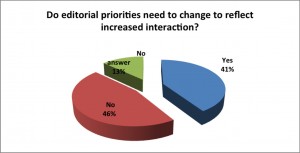I am an enthusiastic freelancer who is excited to work on your projects. As an experienced, talented and professional writer, editor, reporter, educator, translator, and content curator, I am the versatile and ideal choice for your jobs. Both my education and my work experiences have prepared me to handle just about any journalism or related task. I recently earned my M.A. in New Media Journalism. I also have a B.A. in traditional journalism. I have worked at daily newspapers as a staff writer, editor, reporter and paginator. And, I launched my personal news website, The Media Pub. Plus, I have another blog called, Drydens Designer Tools, where I feature educational games, lesson designs and academic writings. With my multimedia and educational experiences, I am prepared for your gigs.

Tag: Blogs
Accuracy and ethics make good news
While people are concerned with the future of News and are embracing digital media, traditional journalists will still have to be gatekeepers and leaders of this new era.
The journalism business now encourages user-generated content with much audience interactivity in the local and editorial news as well as on blogs. Several questions emerge about how this is changing the industry.
According to Francine Hardaway, “Today the media-driven by blogs-is assailed on all sides, by the crushing economics of their business, dishonest sources, inhuman deadlines, page view quotas, inaccurate information, greedy publishers, poor training, the demands of the audience, and so much more.”
However, it is those of us who care about the possible decline of good journalism that will help to fix what is becoming “indistinguishable” between real and fake journalism. When bloggers deliberately publish inaccuracies, they later correct them, just to produce even more page views, writes Hardaway.
Hardaway writes about the digital writers who lure readers in for clicks. And “how blogs-even the most trusted ones-invent stories or publish rumors, just to get a post up and some page views, and then wait to see if anyone comments.”
But she also writes that the future of news is promising because there are journalism schools like ASU’s Cronkite School of Journalism that is doing a good job at preparing students for the future.
“So Cronkite is inadvertently turning out students who are trained in ethics, quality and accuracy into a quagmire of media manipulation…,” writes Hardaway. She promises to be a part of the faculty that will help to train these students.
Meanwhile, we have learned that this evolution in the news will be ongoing. The digital era will not be the last stage of the news cycle. Therefore, some are wondering how far will the interactive nature of news go.
Writers, Penny O’Donnell, senior lecturer in International Media and Journalism at University of Sydney, and David C. McKnight, associate professor of Journalism and Media Research at the Centre at University of New South Wales, ask “whether editorial priorities had changed in response to this greater interactivity with readers…” They report that 46 per cent said that they did not, while 41 per cent “accepted” that they had.
We have seen where even traditional journalists have accepted the blurring of traditional boundaries between audience and journalists. Some of us consider the interactivity very democratic. But we are reminded that traditional journalists need to be the leaders of this evolution.
O’Donnell and McKnight write that, “there are persistent doubts as to what journalism will look like when journalist put down their old mantle of ‘gatekeeper’ and instead take up a new role as ‘facilitator’ or ‘curator’ of multi-participant news conversations.”
According to the writers, “professional journalist must maintain strict control over editing and the output.”
Susan Currie Sivek writes about the message Richard Gingras, head of news products at Google, conveyed to the Association for Education in Journalism and Mass Communication, (AEJMC) in Chicago.
She notes that he encouraged educators to take the lead in shaping the changes that are happening in the media through their curricula. “Educators will also have to take risks in their teaching and advising to help students achieve the skill set and perspective Gingras recommends – and perhaps, to bring about a ‘renaissance’ in the field.”

The influence of Facebook, X (formerly Twitter), blogs, IG, and other media platforms have engaged audience conversations and have also evolved traditional media such as newspapers, magazines, and television.


The emergence of social media in several areas of society is causing a stir among media junkies and those less receptive to the changes.
When change happens in media, or our culture, people usually resort to relentless discussions about it. While there are skepticism and controversy about the role of social media in the news and pop-culture, many are embracing them.
Blogger, Cara McDonough, writes a piece about how her 73-year-old father is now using social media such as Twitter and Facebook to voice his political opinions.
McDonough said that her father just recently identified the differences between social and traditional media when he said, “‘A column is in print… A blog is in the atmosphere.’”
However, Misha Schubert writes that, “newspapers and television still have much greater audience reach than segments of social media…” at the moment.
Regardless, Schubert quotes Greg Jericho who wrote a book on social media, “‘Jericho predicts that within a decade we’ll have voters who not only can’t remember a time before…they couldn’t access the net on their phones.’”
There are some people who see the positive benefits of social media in our lives. But those who do not, are criticizing them that they open up a world for anonymous hate messages, profanity and unregulated mockery on subject matters.
Steven Weber writes in his blog that, “Social media has created a legion of social delinquents, billions of people speaking not their minds, but their spleens, venting everything…”
Nevertheless, social media continue to grow, making more intimate connections.
According to McDonough’s blog, “ A Nielsen survey shows that 22.8 million people over 65 got online in September 2011, an increase of 4 million, [over year ago].”
People use social media for more than just commenting and voicing opinions. Employers are using social media in their recruiting practices. LinkedIn is a popular site that employers visit to find good matches for their job positions.

Marie Solis writes that, “many take it upon themselves to explore social media sites to investigate job candidates.”
Apart from the discontent about the use of social media in our lives, many find these sites allow them to exercise their liberty by expressing themselves, whether their comments are negative or positive.
The discussion will continue about how to better manage these sites. People would like to somehow see more kind comments about celebrities and others in pop-culture. However, when a company makes a defective product, then they would also like to be able to express their dissatisfaction online.
Most of the media types using social media that are now online include television, newspapers, magazines, newsletters, and even radio and podcasts. So, consumers and social media users are exposed to utilizing all forms of media for conversations.
But the evolution of traditional media that are now using social platforms online require alternative models for revenue and funding in order to remain sustainable.
Newspapers and magazines are like public television stations that face financial challenges. Three authors, David D. Kurpius, Emily T. Metzgar, and Karen M. Rowley, try to analyze this crisis in their article, “Sustaining Hyperlocal Media: In search of funding models,” that appears in the journal of Journalism Studies.
These authors believe traditional media are shrinking because it is typical of a mature industry. They argue it is a gradual decline and that we must meet the challenge by trying to find alternative ways to fund new media, or their online presence.
They also note that it is good news for public television because they can fill the niche of providing the local news that traditional media no longer seem to be reporting in detail. Recently, more people are going online and traditional print media are losing advertising revenues.

They also state the newspaper advertising revenues dropped an estimated 23 percent over the past two years since 2010, but newspapers are trying to embrace their online communities while exploring funding models.
— Michelle Dryden is an experienced newspaper journalist with a master’s degree in New Media Journalism from Full Sail University, and a bachelor’s degree in traditional journalism from Rider University.
